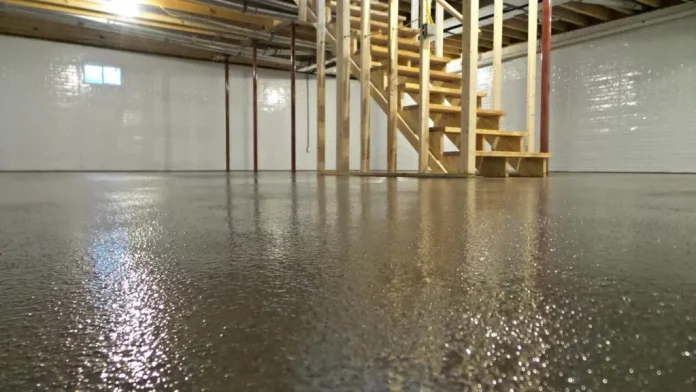Basement waterproofing is an essential process for homeowners looking to protect their properties from water damage and structural issues. A dry, well-maintained basement can add significant value to your home, providing extra living or storage space without the risk of mold, mildew, or other water-related problems. In this article, we’ll cover the importance of basement waterproofing, the different methods available, and tips for maintaining a moisture-free basement.
Why Is Basement Waterproofing Important?
Basements are particularly prone to water infiltration because they are located below ground level, where water can accumulate. Without proper waterproofing, moisture can seep into your foundation, leading to structural damage, mold growth, and a host of other problems. Basement waterproofing not only helps prevent these issues but also improves indoor air quality and prevents costly repairs.
Water intrusion in a basement can result from poor drainage, rising groundwater, or cracks in the foundation. Over time, water pressure from the surrounding soil can force water into the basement, damaging floors, walls, and stored belongings. By investing in basement waterproofing, you are taking preventive measures that can save thousands in potential repairs.
Signs You Need Basement Waterproofing
Several signs indicate that your basement may need waterproofing. Being aware of these early warning signals can help you take action before significant damage occurs. Look out for:
- Damp or musty odors: Persistent dampness in your basement often signals water infiltration.
- Cracks in the foundation: Horizontal, vertical, or stair-step cracks in the foundation walls can let water in.
- Water stains: Water marks or mold on walls and floors are red flags that moisture is getting in.
- Pooling water: If you notice water pooling on the floor or around your foundation after a storm, it’s time to consider waterproofing solutions.
- Efflorescence: This is a white, chalky residue left by evaporated water and is a common sign of moisture problems.
Types of Basement Waterproofing Methods
When it comes to basement waterproofing, homeowners have several options depending on the source and severity of water infiltration. These methods can be categorized into interior and exterior solutions, each with its own advantages.
1. Exterior Waterproofing
Exterior waterproofing is the most comprehensive method and involves protecting the outside of your home from water infiltration. It typically requires excavation around the foundation and applying a waterproof membrane or sealant.
- Waterproof membranes: A waterproof barrier is applied to the foundation walls to block moisture from entering.
- Drainage systems: Exterior drainage systems, such as French drains, direct water away from your foundation, preventing water buildup around your home.
- Grading: Properly grading the soil around your home can help divert water away from the foundation.
Exterior basement waterproofing is highly effective but can be costly due to the excavation required. However, it is the best long-term solution for homes with chronic water issues.
2. Interior Waterproofing
Interior waterproofing solutions are more affordable and less invasive than exterior methods. While these techniques do not stop water from entering your home, they help manage and control water that makes its way inside.
- Sealants and coatings: Applying waterproof sealants or coatings to interior walls can help block minor water seepage. These are ideal for homes with small cracks or occasional moisture issues.
- Sump pumps: A sump pump is a device installed in the lowest part of your basement that automatically pumps out water before it can cause damage. It’s a great option for homes in areas prone to flooding.
- Interior drainage systems: Similar to exterior drainage, an interior system collects and directs water away from the foundation and into a sump pump for removal.
3. Hybrid Methods
In some cases, a combination of both interior and exterior waterproofing may be the best solution. For example, you might install an exterior membrane to block water and an interior drainage system for added protection.
Choosing the Right Basement Waterproofing Method
Selecting the best waterproofing method depends on several factors, including the cause of water infiltration, the condition of your foundation, and your budget. If your basement suffers from chronic flooding or significant water damage, exterior waterproofing is likely the best option. For homes with minor leaks or occasional moisture, interior solutions may be sufficient.
It’s essential to consult with a professional waterproofing contractor who can assess your basement and recommend the most effective solution.
Basement Waterproofing Maintenance Tips
Even after your basement has been waterproofed, regular maintenance is crucial to ensure that the system continues to function effectively. Here are some maintenance tips to keep your basement dry:
- Inspect your foundation regularly: Look for any new cracks or signs of water infiltration.
- Clean gutters and downspouts: Ensure that water is being directed away from your foundation by maintaining clear gutters.
- Check the sump pump: Test your sump pump periodically to ensure it’s working correctly, especially before the rainy season.
- Maintain proper grading: Ensure the soil around your home slopes away from the foundation to prevent water from pooling near the walls.
Conclusion
Basement waterproofing is an essential investment for any homeowner looking to protect their home’s foundation, prevent water damage, and improve indoor air quality. Whether you choose exterior, interior, or hybrid waterproofing methods, taking action before water infiltration causes significant damage can save you from costly repairs in the future.
By maintaining a moisture-free basement, you create a healthier, more functional space that can be used for storage, living, or entertainment without worry. For the best results, consult with a waterproofing professional to assess your needs and find the right solution.




















